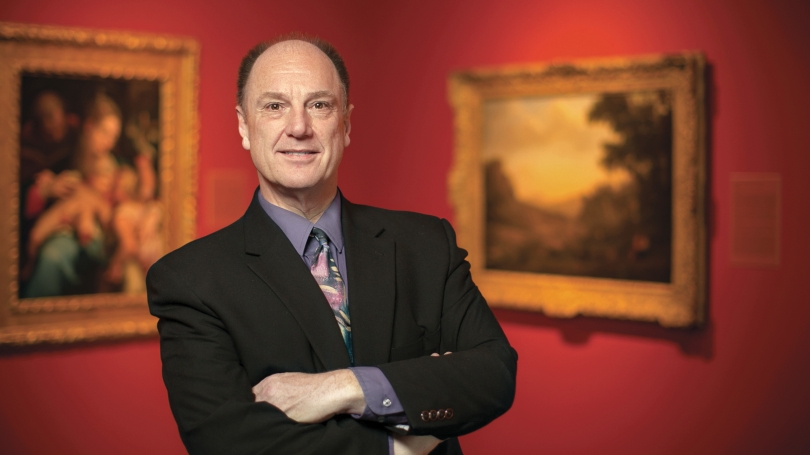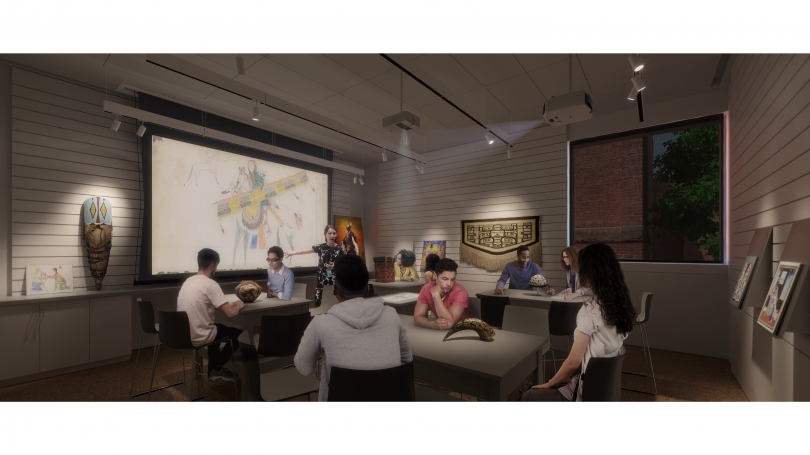Hood Quarterly, fall 2017
John Stomberg, Virginia Rice Kelsey 1961s Director
Center for What?
Object-based inquiry might not roll off the tongue, but it perfectly describes the core activity of the Hood. Objects hold myriad stories. Over decades, centuries, and even millennia these stories multiply, expand, and evolve. Through it all, the objects themselves remain, steadfast beacons of individuals, communities, and eras long gone.
The Hood houses a wide variety of fine art, decorative art, and material and visual culture. All this material makes demonstrable contributions to our work. We ask probing questions of every object in our care. What is it? Where did it come from? Who made it? Why was it made? What does it mean? How did it achieve meaning when it was made, and what sorts of meanings does it embody today? What issues did the maker face, and how did those impact the shape and look of the object? What can we learn about ourselves and our lives by careful contemplation of the work before us?
These are just a few examples of the deep inquiry that takes place in our museum. We do not assume fixed answers. While the objects remain constant, we understand that their significance morphs over time. A portrait of an American statesman aligned with England painted in 1769 had a different resonance at the time it was painted than it would have had seven years later, not to mention in 1876 or 1976 (the centennial and bicentennial years). The image stayed the same, but the interpretation might have shifted from Loyalist to tyrant to interesting protagonist in a historical drama. And perhaps today the same picture represents something entirely unanticipated in the past; it will surely shift again in the years that follow.
These sorts of explorations occur every day in the Hood’s teaching spaces, and for this reason we made a very difficult decision early in the design process for the new building. Not only would the expanded Hood boast a new place for class visits, it would include an entire study center with classrooms, an office, a lobby, archives, and a staging area. Imagine how many more public galleries the Hood could have included instead. The creation of the Center for Object-Based Inquiry reflects a strongly held value. It embodies the core belief that objects occupy the center of our intellectual discipline—they are the sun around which our observations, concerns, revelations, and theories orbit.
We charged Tod Williams and Billie Tsien with making spaces conducive to deep engagements with real things. To this end, they have designed three different classrooms that provide opportunities for close observation and easy communication, while responding to the needs for different class sizes and types, from small seminars to larger lecture courses. Key to the Hood method is looking and discussing—both combine to make the experience lasting and impactful. The classroom spaces had to offer direct access to the objects, and encourage dialogue. The architects have designed each classroom to have distinct functionality. The center will offer professors the opportunity to have one large table that hosts an entire class, multiple tables for smaller breakout groups, or an arrangement more like theater seating. All teachers have individual goals for their time at the Hood, and the museum will be in a position to customize the experience of every class using the facility.
While our museum visitors will be treated to sixteen galleries featuring great works of art from around the globe and throughout history, Dartmouth students will be busy asking questions of objects. Their experiences will help shape their worldview, their knowledge of history, and the way they engage with the others. For this reason, we committed the time, space, and resources to create a greatly enhanced teaching center. It will be a place for exchanging ideas, expanding minds, and making profound connections between people otherwise condemned to remain separated by time and space.

